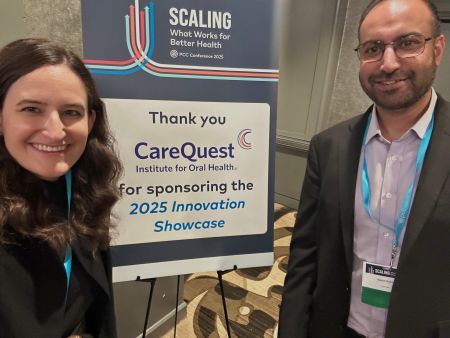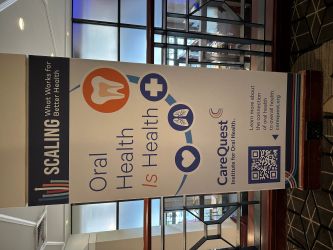Enter your email to receive the CareQuest newsletter:
June 9, 2025
By Katie D’Amico, MBA, Vice President Growth & Innovation, CareQuest Innovation Partners and Azeem Mallick, MBA, Vice President, Enterprise Strategic Partners, CareQuest Institute
“We leave dental out all the time. It makes no sense.”

“The mouth is the gateway to the body, so focusing on oral health has great impact on other conditions downstream.”
“The best care meets the demands of the life of the patient.”
Those quotes — and others like them — stuck with both of us as we flew home from Washington, DC, after “Scaling: What Works for Better Health,” the 2025 Primary Care Collaborative Conference last week. There, we had the opportunity to hear leaders from across the health care landscape discuss innovative new approaches to primary care delivery and payment. And we were excited to bring oral health to the discussions.
We know that oral health is overall health — and that improving one will improve the other. We were excited to hear that the primary care community agrees. Throughout the conference, we received a lot of great input and acknowledgement that oral health should be a part of the overall holistic care model for patients. And there was consensus that any work that helps make the linkage to the primary care setting, especially with underserved populations, adds great value.
Primary care providers (PCPs) are doing incredible work. The question is: How can the oral health community support and integrate with that work? These four takeaways from the conference shined a light on trends that are shaping primary care. At the end of each one, we offer a question about opportunities for integration between oral health and overall health.
The Overlaps Between Oral Health and Overall Health
1. Prevention is the foundation of health.

- Both primary care and oral health care are converging on the same insight: Prevention, including good nutrition, is central to long-term health.
- Both systems must shift from treating symptoms to addressing root causes of chronic disease. (Focus on “roots” of chronic disease, not the “fruits.”)
- Current policies and payment models disincentivize prevention. We need to invest in keeping people healthy, not just treating illness.
- As one speaker, Vivek Garg, MD, MBA, Chief Medical Officer for Humana’s Primary Care Organization, put it, “Primary care is the best drug ever created.”
Consider: How can primary care embed basic oral care to deliver more holistic preventive care and improve outcomes?
2. Collaboration is essential for systemic change.
- Tackling complex health challenges requires strategic, cross-sector collaboration.
- Regional efforts, like coalitions of employers negotiating with payers, are gaining traction and proving more effective than isolated efforts. We heard promising examples of stakeholders leaving their logos at the door and solving for what the community needs.
- Primary care is a rare bipartisan issue, offering a unique opportunity for unified action. Medicaid cuts threaten the entire system, with ripple effects on access and infrastructure for all, regardless of insurance type. Nursing homes, for example, could face an even more challenging reality if the cuts come to fruition.
- We need a public health awareness campaign to elevate the value of primary care in the public’s mind, a point Leslie Crutchfield, Executive Director of Business for Impact at Georgetown’s McDonough School of Business, made in an engaging presentation.
Consider: How can the dental crisis drive consumer change that benefits primary care? How could primary and oral care collaborate to drive consumer activation? And, going a step further, how can oral health drive that collaboration?
3. Innovation, leadership, and technology tools are key to the solution.

- PCPs are overwhelmed — many with an estimated 27 hours of work needed per day — highlighting the need for better tools and support, including GenAI.
- The system has the heart and brain, but it needs more spine — leaders willing to take bold, courageous steps. That sentiment, shared by Robert Pearl, MD, author of ChatGPT, MD: How AI-Empowered Patients & Doctors Can Take Back Control of American Medicine, resonated in the hallways after the sessions ended.
- The Centers for Medicare & Medicaid Services is setting the tone of modernization: Tech ecosystems must integrate and loop data back to PCPs to be effective. In fact, CMS hosted an in-person listening session to discuss a Request for Information (RFI) on improving technology to empower Medicare beneficiaries.
Consider: How can technology better link oral health and overall health to benefit patients? For example, how could better oral health data, including from saliva and the oral microbiome, benefit patients?
4. Employers are critical drivers of change.
- Post-pandemic, employers are grappling with a less healthy workforce, especially those with diverse employee bases.
- There’s growing momentum among employers to prioritize primary care and mental health as essential to workforce productivity.
- A healthy workforce is a thriving workforce, and employers are increasingly recognizing their role in health system transformation.
Consider: What plans, designs, and care models that integrate oral and overall health will prove to be the most effective?
PCPs are continuing to find new innovative ways to do more with less. The oral health community needs to continue to find ways to support them in that journey.